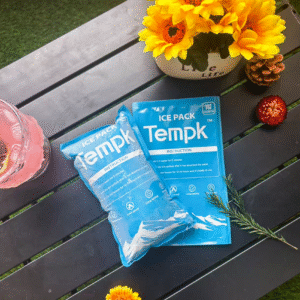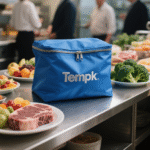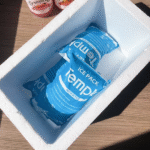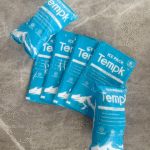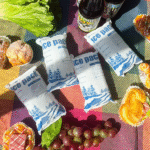Wie Trockeneisbeutel die Lebensmittellieferung und Kühlkettenlogistik verbessern
Trockeneisbeutel verändern die Essenslieferung grundlegend, spielen eine entscheidende Rolle bei der Aufrechterhaltung der Qualität und Sicherheit verderblicher Produkte. Indem wir eine Kühllösung anbieten, die herkömmliche Eis- oder Gel-Packs bei weitem übertrifft, Trockeneis sorgt dafür, dass gefrorene Waren wie Meeresfrüchte aussehen, Fleisch, und Essenssets bleiben während des Transports in optimalem Zustand. In diesem Leitfaden werden die Vorteile erläutert, Best Practices, und aktuelle Trends bei der Verwendung von Trockeneis bei der Lebensmittellieferung, Unterstützung von Unternehmen bei der Optimierung ihrer Kühlkettenlogistik.
-
Warum sind Trockeneisbeutel sind für die Lebensmittellieferung von entscheidender Bedeutung?
-
Was sind die besten Praktiken für die Verwendung von Trockeneis bei Lebensmittellieferungen??
-
Wie können Unternehmen ihren Lebensmittellieferprozess mit Trockeneis optimieren??
-
Was sind die wichtigsten Trends, die die Kühlkettenlogistik verändern? 2025?
Warum sind Trockeneisbeutel für die Lebensmittellieferung so wichtig??
Trockeneisbeutel sind in der Lebensmittellieferbranche unverzichtbar, insbesondere für Sendungen, die eingefroren oder gekühlt werden müssen. Im Gegensatz zu traditionellem Eis, das zu Wasser schmilzt und zu durchnässten Verpackungen oder Verunreinigungen führen kann, Trockeneis bleibt fest, während es direkt in Kohlendioxidgas sublimiert. Diese Eigenschaft hilft, Lebensmittel über längere Zeiträume auf der erforderlichen Temperatur zu halten, Reduzierung des Verderbs und Gewährleistung der Produktintegrität.
Hauptvorteile von Trockeneis bei der Lebensmittellieferung
-
Überlegene Kühlleistung: Trockeneis hält Temperaturen bis zu -78,5 °C aufrecht (-109.3° F), Daher ist es ideal für Tiefkühlkost wie Eiscreme, Fleisch, und Meeresfrüchte. Im Gegensatz zu Eis- oder Gelpackungen, die Produkte nur kurzzeitig kühl halten können, Trockeneis sorgt dafür, dass Produkte länger gefroren bleiben, Damit eignet es sich perfekt für den Fernversand.
-
Kein Schmelzwasser: Einer der größten Nachteile bei der Verwendung von normalem Eis ist das Wasser, das dabei zurückbleibt. Trockeneis, Jedoch, sublimiert direkt in Gas, ohne Flüssigkeitsrückstände zu hinterlassen, Dabei bleiben sowohl die Unversehrtheit der Verpackung als auch die Frische der Produkte erhalten.
-
Kosteneffizienz: Während Trockeneis auf den ersten Blick teuer erscheinen mag, Es ist eine kostengünstige Lösung für den Versand von Tiefkühlkost über große Entfernungen. Es sorgt für eine gleichmäßige Kühlumgebung und verringert das Risiko des Verderbens, Dadurch können Unternehmen potenziell erhebliche Abfallkosten einsparen.
Best Practices für die Verwendung von Trockeneis bei Lebensmittellieferungen
Zur Optimierung der Trockeneisnutzung, Unternehmen müssen die Best Practices der Branche befolgen, um sicherzustellen, dass Lebensmittel frisch bleiben und die Sicherheitsvorschriften einhalten.
1. Wie viel Trockeneis sollte verwendet werden??
Die Menge an benötigtem Trockeneis hängt von verschiedenen Faktoren wie der Sendungsgröße ab, Transitdauer, und die Art der versendeten Lebensmittel. Als Faustregel, 5 Zu 10 Pro Pfund sollten Trockeneis verwendet werden 24 Stunden des Versands. Für längere Sendungen oder größere Bestellungen, Möglicherweise ist mehr Trockeneis erforderlich.
2. Richtige Verpackung für Trockeneis
Um die Sublimationsrate von Trockeneis zu verlangsamen, ist es wichtig, eine isolierte Verpackung zu verwenden, sorgt dafür, dass die kalte Luft möglichst lange erhalten bleibt. Auch die Verpackung sollte belüftet sein, damit das Kohlendioxidgas entweichen kann und ein gefährlicher Druckaufbau vermieden wird.
3. Kennzeichnungs- und Sicherheitsrichtlinien
Versandverpackungen mit Trockeneis müssen entsprechend gekennzeichnet sein “Kohlendioxid-Feststoff” Gefahrensymbole. Dies ist durch internationale Schifffahrtsvorschriften erforderlich, um eine ordnungsgemäße Handhabung sicherzustellen und alle Parteien über das Vorhandensein von Trockeneis zu informieren, Dies kann gefährlich sein, wenn es nicht richtig gehandhabt wird.
4. Temperaturüberwachung
Für optimale Ergebnisse, Temperaturüberwachungsgeräte sollten im Lieferumfang enthalten sein. Diese Geräte überwachen die Temperatur während des gesamten Transports, So können Unternehmen sicherstellen, dass Lebensmittel im erforderlichen Temperaturbereich bleiben, und bei Bedarf schnelle Korrekturmaßnahmen ergreifen.
5. Sichere Handhabung durch die Empfänger
Es ist von entscheidender Bedeutung, die Empfänger über den sicheren Umgang mit Trockeneis aufzuklären. Denn Trockeneis sublimiert zu Kohlendioxid, Es ist wichtig, es an einem gut belüfteten Ort aufzubewahren und den direkten Kontakt mit bloßer Haut zu vermeiden. Es sollten klare Anweisungen zur sicheren Handhabung und Entsorgung des Trockeneises gegeben werden.
Best Practices für das Verpacken
| Verpackungsfaktor | Empfohlene Praxis | Warum ist es wichtig |
|---|---|---|
| Menge Trockeneis | Verwenden 5-10 lbs pro 24 Std. | Verhindert Temperaturschwankungen |
| Verpackungsisolierung | Verwenden isoliert, belüftete Boxen | Hält die Kälte länger und vermeidet Druckaufbau |
| Beschriftung | Markieren Sie richtig mit “Kohlendioxid-Feststoff” Etikett | Gewährleistet eine sichere Handhabung und Compliance |
| Überwachung | Integrieren Sie Temperaturüberwachungsgeräte | Bietet Echtzeitdaten zu den Versandbedingungen |
So optimieren Sie Lebensmittellieferprozesse mit Trockeneis
Optimieren Sie den Prozess der Lebensmittellieferung und stellen Sie sicher, dass die Lieferungen frisch ankommen, Unternehmen müssen strategisch vorgehen.
1. Analysieren Sie historische Versanddaten
Überprüfen Sie frühere Lieferungen, um Muster bei Temperaturschwankungen zu erkennen, Verwendung von Trockeneis, und Verpackungseffizienz. Diese Daten können Unternehmen dabei helfen, ihre Kühlkettenprozesse zu optimieren, Reduzierung der Kosten und Verbesserung der Versandleistung.
2. Arbeiten Sie mit Experten zusammen
Durch die Zusammenarbeit mit Logistikdienstleistern, die auf den Kühlkettenversand spezialisiert sind, kann die Effizienz deutlich gesteigert werden. Diese Experten können wertvolle Einblicke in die besten Praktiken für die Verwendung von Trockeneis geben, Wir helfen Unternehmen dabei, Sendungen sorgfältig abzuwickeln und den Ressourceneinsatz zu optimieren.
3. Schulung für Teammitglieder
Eine ordnungsgemäße Schulung ist unerlässlich, um Fehler zu reduzieren und die Effizienz des Trockeneis-Verpackungsprozesses zu verbessern. Stellen Sie sicher, dass Ihr Team mit der Handhabung vertraut ist, Verpackung, Beschriftung, und Einhaltung gesetzlicher Vorschriften, um Risiken zu minimieren und die betriebliche Effizienz zu steigern.
4. Technologieintegration
Der Einsatz fortschrittlicher Logistiksoftware kann Unternehmen dabei helfen, den Trockeneisverbrauch zu optimieren. KI-gesteuerte Plattformen können den Trockeneisbedarf anhand verschiedener Faktoren vorhersagen, Automatisieren Sie die Temperaturverfolgung, und Versandwege optimieren, All dies trägt zu reibungsloseren und kostengünstigeren Versandprozessen bei.
Trends bei der Verwendung von Trockeneis und bei der Lebensmittellieferung in 2025
Während sich die Lebensmittellieferbranche weiterentwickelt, Es zeichnen sich mehrere neue Trends ab, die sich auf die Verwendung von Trockeneis und den Versand von Lebensmitteln auswirken.
Nachhaltigkeit und umweltfreundliche Verpackung
Angesichts der wachsenden Besorgnis über die Auswirkungen auf die Umwelt, Viele Unternehmen setzen auf nachhaltige Verpackungslösungen. Neben Trockeneis werden biologisch abbaubare Materialien und umweltfreundliche Isolierung verwendet, um den gesamten CO2-Fußabdruck von Lebensmittellieferungen zu reduzieren.
Erweiterte Temperaturüberwachung
Der Einsatz von IoT-gestützten Temperaturüberwachungssystemen wird immer häufiger. Diese Systeme bieten Echtzeitverfolgung und Warnmeldungen, wenn die Temperatur vom gewünschten Bereich abweicht, Wir helfen Unternehmen dabei, schnell zu reagieren, um Verderb zu verhindern.
Interaktive Verpackung für bessere Kundenbindung
Interaktive Verpackungen, die es Kunden ermöglichen, ihre Sendungen zu verfolgen und die Temperaturbedingungen zu überwachen, werden immer beliebter. Dies verbessert das Kundenerlebnis, indem es für mehr Transparenz sorgt und das Vertrauen in den Lieferprozess erhöht.
Markteinsichten
Da die Nachfrage nach frischen und biologischen Lebensmitteln weiter steigt, Der Bedarf an einer zuverlässigen und effizienten Kühlkettenlogistik wird immer wichtiger. Unternehmen, die fortschrittliche Kühlkettentechnologien und Best Practices einsetzen, sind gut aufgestellt, um der steigenden Nachfrage gerecht zu werden und auf dem Weltmarkt wettbewerbsfähig zu bleiben.
Häufig gestellte Fragen
Q1: Warum sollte ich Trockeneis für die Essenslieferung verwenden??
Trockeneis ist unerlässlich, um Lebensmittel während des Transports gefroren zu halten, um sicherzustellen, dass es frisch und sicher bleibt. Es sorgt für eine länger anhaltende Kühlung und vermeidet Wasserschäden, die herkömmliches Eis verursachen kann.
Q2: Wie lange ist Trockeneis bei der Lebensmittellieferung haltbar??
Trockeneis kann 24–48 Stunden lang niedrige Temperaturen aufrechterhalten, Abhängig von der verwendeten Menge und der Isolierung in der Verpackung. Es ist ideal für Langstreckentransporte, die eine längere Kühlung erfordern.
Q3: Sind Trockeneisbeutel sicher in der Handhabung??
Ja, solange die entsprechenden Sicherheitsprotokolle befolgt werden. Handschuhe tragen, Sorgen Sie für eine angemessene Belüftung, und stellen Sie sicher, dass Trockeneis offen gehandhabt wird, gut belüftete Räume, um Verletzungen oder Erstickung zu vermeiden.
Schlussfolgerung und Empfehlungen
Für den sicheren Transport verderblicher Lebensmittel sind Trockeneisbeutel unverzichtbar, konsistente Bereitstellung, langanhaltende Kühlung, die herkömmliches Eis nicht bieten kann. Durch die Befolgung von Best Practices wie der richtigen Verpackung, Beschriftung, und Temperaturüberwachung, Unternehmen können ihre Kühlkettenabläufe optimieren und die Qualität ihrer Produkte sicherstellen.
Umsetzbare Vorschläge:
-
Überprüfen und optimieren Sie Ihre aktuellen Lebensmittellieferprozesse, indem Sie bewerten, wie Trockeneis Ihre Versandeffizienz verbessern kann.
-
Investieren Sie in fortschrittliche Temperaturüberwachungstechnologie, um während des gesamten Versandprozesses eine hochwertige Kontrolle aufrechtzuerhalten.
-
Arbeiten Sie mit Logistikdienstleistern zusammen, die auf Trockeneistransporte spezialisiert sind, um Compliance und Effizienz sicherzustellen.
Über Tempk
Und Tempk, Wir sind spezialisiert auf die Bereitstellung innovativer Kaltkettenlösungen, bietet hochwertige Trockeneisbeutel und Verpackungslösungen, die auf die Lebensmittel- und Pharmaindustrie zugeschnitten sind. Unsere Produkte sorgen dafür, dass Ihre Waren frisch und sicher bleiben, unabhängig von der Versandentfernung.
Aufruf zum Handeln: Kontaktieren Sie Tempk noch heute, um mehr über unsere Trockeneisbeutel zu erfahren und wie wir Ihnen bei der Optimierung Ihrer Kühlkettenlogistik helfen können.






